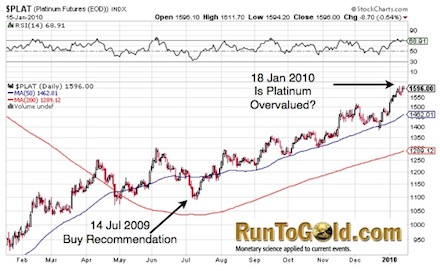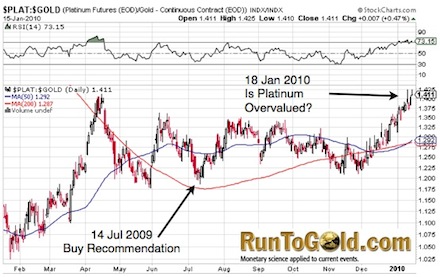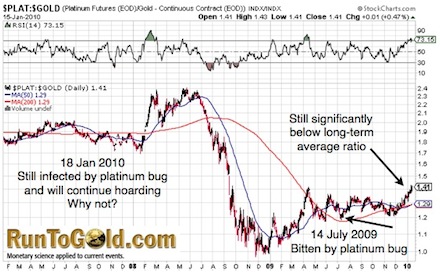

Posted 18 Jan 2010
I like round numbers because they are easier to count. For example, on 14 July 2009 I recommended buying platinum at $1,118 and today it trades at $1,618.
I like an unrealized gain of $500 per ounce in 6 months which translates into 44.7% in little colored coupons or 17.5% in gold. But is platinum overvalued and how can we tell whether we should buy more, hold or sell?![]()
![]()

VALUE CALCULATION
Commodities are produced because they add value to society. Wheat is to eat, oil is for fuel, steel is for building and platinum is mainly for catalytic converters in automobiles. Why is gold produced? There are plenty of tons of it in aboveground stockpiles, decades based on annual consumption, so why burrow miles into the earth to bury it in a vault?
The value gold adds to society is in its ability to assist us in performing mental calculations of value. When using gold as the numeraire a much more accurate assessment can be made when allocating capital. The third round of this gold upleg is just starting.
TECHNICAL ANALYSIS
 In July 2009 the platinum to gold ratio was below 1.2 and currently it is around 1.41. The extrinsic value of platinum has risen about 17.5%, when priced in FRN$ about 45% and when compared to the earlier upleg in April platinum is looking pretty expensive. But as Professor Jastram explained in The Golden Constant all commodities tend to return to orbit around gold. So where is platinum's natural orbit?
In July 2009 the platinum to gold ratio was below 1.2 and currently it is around 1.41. The extrinsic value of platinum has risen about 17.5%, when priced in FRN$ about 45% and when compared to the earlier upleg in April platinum is looking pretty expensive. But as Professor Jastram explained in The Golden Constant all commodities tend to return to orbit around gold. So where is platinum's natural orbit?
 The natural orbit for platinum is around 1.8 to 2.1 ounces of gold per ounce of platinum.
The natural orbit for platinum is around 1.8 to 2.1 ounces of gold per ounce of platinum.
But this is just a cursory technical analysis. To be sure of one's assertion an analysis of the fundamentals under the Austrian school of economics is also important to undertake.
FUNDAMENTAL ANALYSIS
Platinum is an extremely rare but widely used precious metal. For example, the annual worldwide platinum mining production is valued at about $7.8B compared to about 75M ounces of annual gold production or the FDIC’s $0 of reserves and a $500B line of credit with the Treasury to cover $4,831B of insured deposits. In other words, platinum is a lot rarer than gold and gold is a lot rarer than little colored coupons.
According to the USGS 2006 Minerals Yearbook of the 239 tonnes of refined platinum sold in 2006, 130 tonnes were used for automobile emissions control devices, 49 tonnes were used for jewelry, 13.3 tonnes were used in electronics, and 11.2 tonnes were used by the chemical industry as a catalyst. The remaining 35.5 tonnes produced were used in various other minor applications, such as platinum jewelry, platinum rings, electrodes, anticancer drugs, oxygen sensors, spark plugs and turbine engines. Platinum uses, like uses of silver, are multitudinous.
The giant wealth destruction team headed by the Vampire Squid In Chief Obama thinks that destroying perfectly functioning automobiles, with perfectly functioning catalytic converters, is a recipe for economic prosperity. Additionally, billions of dollars of federal funds are being directed towards the Green Economy. What do new cars and the green economy need? Lots and lots of platinum.
And we all know the giant wealth destruction machine known as government always buys at a good price. As their little colored coupons continue evaporating in The Great Credit Contraction holders of capital will continue scrambling for tangible assets. But evaporating platinum takes a lot of effort because its melting point is 1,768.3 °C or 3,214.9 °F compared to gold’s 1,947.52 °F, silver’s 1,763.2 °F and it is important to remember that paper ignites at 451°F.
Because of the rising demand for platinum from both public and private parties, the shortage of alternatives for little colored coupons, platinum's excellent monetary attributes and the ability to easily function as currency through innovations like GoldMoney therefore the future looks bright for the silvery-white metallic element. The same principles for buying gold or silver safely apply when considering how to buy platinum.
PLATINUM PRODUCTION
Platinum producers are extremely rare. There have been chronic problems with open cast deep underground platinum mining in South Africa. There is Angloplat (AMSJ.J) which produced 2.5M ounces in 2007, Impala Platinum (IMPUY.PK) which produced 1.9M ounces for year ending 30 June 2008 and is up about 50% since I recommended platinum, Lonmin and Norilsk Nickel (GMKN.MM).
Stillwater Mining Company (SWC) is the only one domestic United States platinum producer, are majority owned by the Russian Norilsk and up about 137% from when I recommended platinum in July.
With commodity producers there tends to be a leveraged effect on earnings relative to the commodity price. Consequently, a significant rise in platinum without hedging will tend to exponentially affect their bottom line either positively or negatively.
CONCLUSION
Platinum has had a tremendous run over the past 6 months and I am pleased with the performance. Platinum is not nearly the incredible value today as it was then and the 50dma and 200dma are not at strategic entry points.
Nevertheless, it is a prime substitute for little colored coupons, goes into the cash portion of the balance sheet, is easily purchased with low margins, is extremely rare relative to the other precious metals, has bright demand prospects and still appears to be undervalued relative to gold by about .4-.7 ounces of gold per ounce of platinum.
So I recommend doing what I have done since being bitten by the platinum bug: accumulating fully paid for physical metal on a consistent regular basis. While I have not exchanged my gold or silver for platinum, largely because of tax considerations, I have shunted most of my gold and silver demand into allocated physical platinum. After all, platinum, like gold and silver, can never become worthless.
DISCLOSURE: Long physical gold, silver and platinum with no interest the problematic SLV or GLD ETFs, the platinum ETFs or in the Angloplat, Impala Platinum (IMPJ.J), Lonmin and Norilsk Nickel (GMKN.MM) or Stillwater Mining Company (SWC).